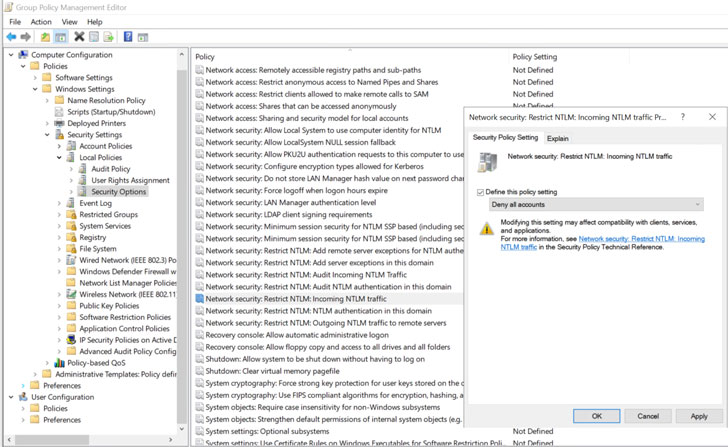A newly uncovered security flaw in the Windows operating system can be exploited to coerce remote Windows servers, including Domain Controllers, to authenticate with a malicious destination, thereby allowing an adversary to stage an NTLM relay attack and completely take over a Windows domain.
The issue, dubbed "PetitPotam," was discovered by security researcher Gilles Lionel, who shared technical details and proof-of-concept (PoC) code last week, noting that the flaw works by forcing "Windows hosts to authenticate to other machines via MS-EFSRPC EfsRpcOpenFileRaw function."
MS-EFSRPC is Microsoft's Encrypting File System Remote Protocol that's used to perform "maintenance and management operations on encrypted data that is stored remotely and accessed over a network."
Specifically, the attack enables a domain controller to authenticate against a remote NTLM under a bad actor's control using the MS-EFSRPC interface and share its authentication information. This is done by connecting to LSARPC, resulting in a scenario where the target server connects to an arbitrary server and performs NTLM authentication.
"An attacker can target a Domain Controller to send its credentials by using the MS-EFSRPC protocol and then relaying the DC NTLM credentials to the Active Directory Certificate Services AD CS Web Enrollment pages to enroll a DC certificate," TRUESEC's Hasain Alshakarti said. "This will effectively give the attacker an authentication certificate that can be used to access domain services as a DC and compromise the entire domain.
While disabling support for MS-EFSRPC doesn't stop the attack from functioning, Microsoft has since issued mitigations for the issue, while characterizing "PetitPotam" as a "classic NTLM relay attack," which permit attackers with access to a network to intercept legitimate authentication traffic between a client and a server and relay those validated authentication requests in order to access network services.
"To prevent NTLM Relay Attacks on networks with NTLM enabled, domain administrators must ensure that services that permit NTLM authentication make use of protections such as Extended Protection for Authentication (EPA) or signing features such as SMB signing," Microsoft noted. "PetitPotam takes advantage of servers where the Active Directory Certificate Services (AD CS) is not configured with protections for NTLM Relay Attacks."
To safeguard against this line of attack, the Windows maker is recommending that customers disable NTLM authentication on the domain controller. In the event NTLM cannot be turned off for compatibility reasons, the company is urging users to take one of the two steps below -
Disable NTLM on any AD CS Servers in your domain using the group policy Network security: Restrict NTLM: Incoming NTLM traffic. Disable NTLM for Internet Information Services (IIS) on AD CS Servers in the domain running the "Certificate Authority Web Enrollment" or "Certificate Enrollment Web Service" servicesPetitPotam marks the third major Windows security issue disclosed over the past month after the PrintNightmare and SeriousSAM (aka HiveNightmare) vulnerabilities.
Found this article interesting? Follow THN on Facebook, Twitter and LinkedIn to read more exclusive content we post.
.png)
 3 years ago
193
3 years ago
193 



















 Bengali (Bangladesh) ·
Bengali (Bangladesh) ·  English (United States) ·
English (United States) ·